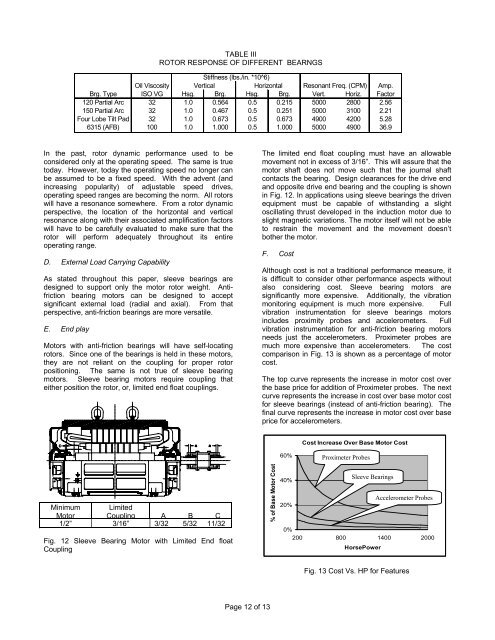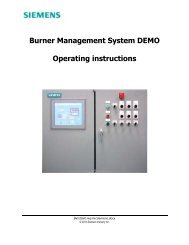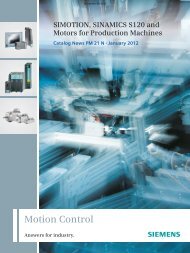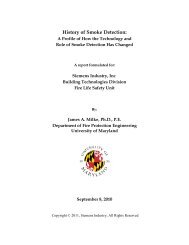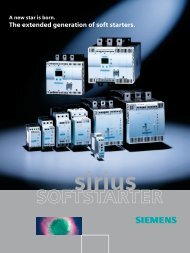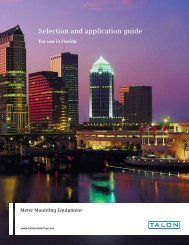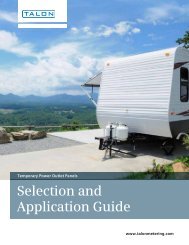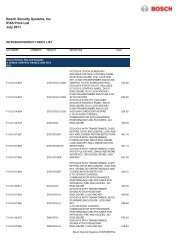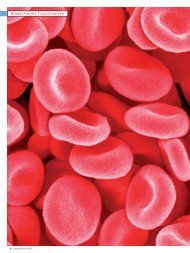Sleeve vs Antifriction Bearings - Siemens Industry, Inc.
Sleeve vs Antifriction Bearings - Siemens Industry, Inc.
Sleeve vs Antifriction Bearings - Siemens Industry, Inc.
You also want an ePaper? Increase the reach of your titles
YUMPU automatically turns print PDFs into web optimized ePapers that Google loves.
TABLE IIIROTOR RESPONSE OF DIFFERENT BEARNGSStiffness (lbs./in. *10^6)Oil Viscosity Vertical Horizontal Resonant Freq. (CPM) Amp.Brg. Type ISO VG Hsg. Brg. Hsg. Brg. Vert. Horiz. Factor120 Partial Arc 32 1.0 0.564 0.5 0.215 5000 2800 2.56150 Partial Arc 32 1.0 0.467 0.5 0.251 5000 3100 2.21Four Lobe Tilt Pad 32 1.0 0.673 0.5 0.673 4900 4200 5.286315 (AFB) 100 1.0 1.000 0.5 1.000 5000 4900 36.9In the past, rotor dynamic performance used to beconsidered only at the operating speed. The same is truetoday. However, today the operating speed no longer canbe assumed to be a fixed speed. With the advent (andincreasing popularity) of adjustable speed drives,operating speed ranges are becoming the norm. All rotorswill have a resonance somewhere. From a rotor dynamicperspective, the location of the horizontal and verticalresonance along with their associated amplification factorswill have to be carefully evaluated to make sure that therotor will perform adequately throughout its entireoperating range.D. External Load Carrying CapabilityAs stated throughout this paper, sleeve bearings aredesigned to support only the motor rotor weight. <strong>Antifriction</strong>bearing motors can be designed to acceptsignificant external load (radial and axial). From thatperspective, anti-friction bearings are more versatile.E. End playMotors with anti-friction bearings will have self-locatingrotors. Since one of the bearings is held in these motors,they are not reliant on the coupling for proper rotorpositioning. The same is not true of sleeve bearingmotors. <strong>Sleeve</strong> bearing motors require coupling thateither position the rotor, or, limited end float couplings.The limited end float coupling must have an allowablemovement not in excess of 3/16”. This will assure that themotor shaft does not move such that the journal shaftcontacts the bearing. Design clearances for the drive endand opposite drive end bearing and the coupling is shownin Fig. 12. In applications using sleeve bearings the drivenequipment must be capable of withstanding a slightoscillating thrust developed in the induction motor due toslight magnetic variations. The motor itself will not be ableto restrain the movement and the movement doesn’tbother the motor.F. CostAlthough cost is not a traditional performance measure, itis difficult to consider other performance aspects withoutalso considering cost. <strong>Sleeve</strong> bearing motors aresignificantly more expensive. Additionally, the vibrationmonitoring equipment is much more expensive. Fullvibration instrumentation for sleeve bearings motorsincludes proximity probes and accelerometers. Fullvibration instrumentation for anti-friction bearing motorsneeds just the accelerometers. Proximeter probes aremuch more expensive than accelerometers. The costcomparison in Fig. 13 is shown as a percentage of motorcost.The top curve represents the increase in motor cost overthe base price for addition of Proximeter probes. The nextcurve represents the increase in cost over base motor costfor sleeve bearings (instead of anti-friction bearing). Thefinal curve represents the increase in motor cost over baseprice for accelerometers.Cost <strong>Inc</strong>rease Over Base Motor Cost60%Proximeter ProbesMinimum LimitedMotor Coupling A B C1/2” 3/16” 3/32 5/32 11/32Fig. 12 <strong>Sleeve</strong> Bearing Motor with Limited End floatCoupling% of Base Motor Cost40%<strong>Sleeve</strong> <strong>Bearings</strong>Accelerometer Probes20%0%200 800 1400 2000HorsePowerFig. 13 Cost Vs. HP for FeaturesPage 12 of 13


